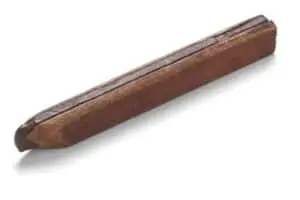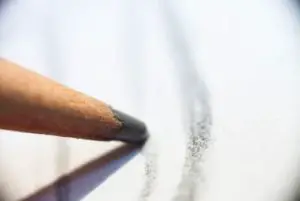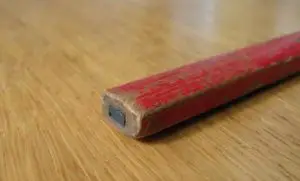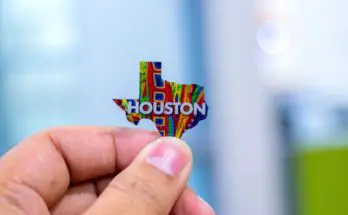As a kid in my dad’s workshop, i can remember him always carrying a “weird” looking pencil that was nothing like the ones I used. As I got older, I learned that he was using a carpenter’s pencil. Once I was old enough to begin helping him with his projects, I learned there were several reasons for the funny looking shape.
History

The word “pencil” comes from the Latin language and originally references the brushes that an artist used.
The discovery of graphite in the early to mid-1500’s had a significant impact on the creation of the pencils as we know today. It wasn’t until over a century later that pencils began being produced in Germany in the 1660’s.
How is a Carpenters Pencil Made?
The process for making pencils has become very efficient since they were first made back in England. A pencil factory recieves “blanks” of wood which are typically rectangle in shape. These blanks are about half the thickness of what the final pencil will become. Each blank is wide enough so that several pencils (8-10+) can be made from it. Lengthwise, the blanks are about 7.5″ or however long the maker is planning to make the end product.
 Upon receiving the blanks, they are loaded into a machine. The machine then separates the blanks from the stack to a single piece on the conveyor. Next, it passes thru a cutter that slots into the tops of the blanks. This slot is where the graphite will be placed later in the process.
Upon receiving the blanks, they are loaded into a machine. The machine then separates the blanks from the stack to a single piece on the conveyor. Next, it passes thru a cutter that slots into the tops of the blanks. This slot is where the graphite will be placed later in the process.
After the slots are cut, the blanks are moved by a conveyor to a machine that places a very thin layer of glue into the slots that were cut in the prior step. After the gluing, it makes its way down the conveyor and every other wood blank is pushed onto a different conveyor forming 2 lines of blanks with slots cut and glue applied. The blanks in one of these lines will get graphite dropped into the slates.
The graphite arrives at then pencil factory in pre-cut sticks based on whatever size pencil is being produced. These sticks are loaded into a piece of equipment that sorts them so that when the wood blank passes under it with the fresh glue, the sticks can be easily placed into the slots that were recently cut.
Now the blanks that have the graphite go through a second glue machine that applies additional lines of glue over the entire piece of wood. The second lane of wood blanks (which do not have graphite) get flipped over and then set onto the blanks that has the graphite – thus making a pencil sandwich.
From here they go to a press that applied pressure from both sides and holds them there for several minutes for the glue to dry. Next the blanks go through an additional cutter that slices the blanks of wood into several individual pencils.
After a quick paint job and packaging, they are on to a truck and off to a store.
Design
The most common shape of a pencil is the round version that you are use to from school. A carpenters pencil is different in shape in that it is more of an elliptical with long flat sides. If you look at one from above while it’s laying flat on a table it might resemble a popsicle stick.
Carpenter Pencil Dimensions
There can be a variance as to the shape and size of a carpenters pencil; however the most common size found is about 19/32″ wide, 1/4″ tall and around 7″ inches long. A regular round pencil that you commonly use is about 1/4″ wide and usually about 7.5″ long.
Why are carpenters pencils flat?

Carpenters pencils are flat in order to keep them from rolling off the surface the carpenter had placed them on. Many times a carpenter or woodworker is holding multiple items in their hand while marking something. They needed to be able to quickly lay their pencil down but know that it will remain in the same spot and not roll away. Thus, the carpenters pencil was born.
Another different design feature for the pencil is the fact that the graphite inside is shaped like a thin rectangle similar to the actual pencil. There’s a reason for this as well! This allows the carpenter to have a wider writing area for marking. This helps keep the graphite sharper and not dull as quickly.
How do I sharpen a carpenters pencil?
There are a couple ways that you can sharpen a carpenters pencil. The major home improvement stores sell pencil sharpeners that allow the carpenter pencils shape to fit into it. You can purchase an electric version or manual handheld versions that can fit into your tool belt.
In my opinion, the best way to sharpen one of these pencils though is the old fashion way of using a regular knife. Here’s a video of an instructor at a carpentry school showing this particular method: Click here. This method allows you to maintain and take advantage of having the wide graphite which helps set it apart from the round shaped pencil.
Mechanical Carpenter Pencils
As with all things, there is a company that has worked on improving the carpenters pencil. A company has developed a mechanical carpenters pencil that is readily available. Both the pencil and the graphite come in the same shape as the traditional pencil that you are accustomed to seeing. These new designed pencils do cost a bit more, but should last much longer too, assuming you don’t lose them. Here’s a popular set that can be found on Amazon.
Since I’m actually terrible at losing pencils, I end up buying them in bulk on Amazon which is a much cheaper option. Plus it allows me to scatter them around the shop so I almost always have one nearby. I typically pick up this set since they come in bright colors and are easy to spot.
How to Remove Pencil Marks from Wood
A few different options are available for removing pencils marks on your wood. If you aren’t worried about damaging the wood or the grain, any of these options should work perfectly fine for you.
- Sanding it away – Just as it sounds, all you need to do is grab a sheet of sandpaper and go over it. There is a risk that this option could damage the wood grain in the spots that you rub. If sanding is the only option, I’d recommend using a very fine sheet of sandpaper.
- Acetone – This another option available to you. A small dab of acetone and wipe of a cloth and the marks should disappear. This method shouldn’t damage the wood or the grain.
Carpenter Pencil Art
If you are looking for something truly unique for a woodworker that you know, then you’ve gotta check out the work of an artist located in Nebraska by the name of Cindy Chinn. Cindy does some incredible work carving scenes or items out of carpenter pencils! Take a look at her site and be in awe of how she creates such detailed pieces of art. Her site is here.




